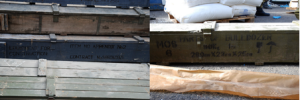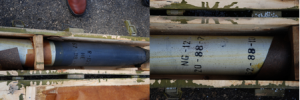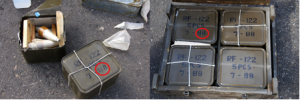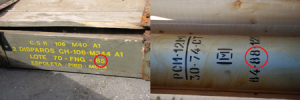North Korea, Hamas, and Hezbollah: Arm in Arm?
North Korea’s arms exports to US-designated terrorist organizations in the Middle East have made headlines twice recently. On July 23, 2014, a US district court ruled that “North Korea and Iran are liable for damages because they provided material support and assistance” to Hezbollah, which enabled the latter’s rocket attacks during the 2006 war with Israel. Only a few days later, the Daily Telegraph claimed that Hamas, “looking for ways to replenish its stocks…because of large numbers it has fired at Israel in recent weeks,” is negotiating a new arms deal with North Korea.
These two developments highlight the historical, and possibly continuing, arms relationship between North Korea and non-state actors in the Middle East. A general consensus among analysts is that today, North Korea’s dominant motivation for arms sales is the possible financial gain—a driver which may well apply to North Korea’s provision of weaponry to groups like Hezbollah and Hamas. Yet the picture appears to be more complex than mere economics. As Balazs Szalontai at Kookmin University has also noted, Pyongyang’s relationships with non-state groups have historically tended to form part of their relationship with a state friend, in this case, Iran and Syria.[1] North Korea’s desire to show they are “in the same trench” with friendly governments by helping their clients, may complement economic motivations for the sale. By extension, such assistance therefore also contributes to North Korea’s foreign policy goals by undermining the strength of its enemies.
North Korea’s relationship with armed groups in the Middle East has likely primarily involved three formats: training, infrastructure support and the provision of weapons. Palestinian militants, including one of the founding members of Fatah, received training in North Korea as early as the 1960s. Hezbollah also allegedly benefitted from such training in the 1980s and 1990s. Pyongyang has also reportedly supported Hamas and Hezbollah in building tunnels and underground facilities, a speciality of the North Koreans, whose networks under the DMZ are renowned. As noted in the Memorandum Opinion in the recent case of Chaim Kaplan et al v. Hezbollah, “prior to July 12, 2006, North Korea provided Hezbollah with…assistance in building a massive network of underground military installations, tunnels, bunkers, depots and storage facilities in southern Lebanon.”
Yet it is the idea of North Korean-manufactured weapons in the arms of Hamas and Hezbollah militants in particular that has captured international media attention this week. Are continuing ties plausible? Assuming the Telegraph’s report about Hamas restocking with North Korean help is accurate, what could they be interested in buying from North Korea? And, is Iran involved in this curious long-distance relationship?
Contemporary open-source information is thin, making it difficult to independently substantiate claims of current activity. However, a closer look at previous arms interdictions, what appear to be the procurement priorities of Hamas and Hezbollah, and North Korean manufacturing capabilities, can shed a small ray of light on the possible trajectory of these relationships and the role of Iran.
The Arms Bazaar
The 2008-2009 period offers a relatively substantial degree of (admittedly dated) information on North Korea’s relationships with Hamas and Hezbollah. During that time, there appear to have been four confirmed seizures of North Korean cargo en route to Iran or Syria, where Hamas or Hezbollah could have been the end-users. Information on the weapons seized in those cargoes is useful in figuring out the present shopping list of the two groups.
In 2008, two containers filled with “rocket fuses” bound for Bandar Abbas in Iran were seized by an unspecified United Nations Member State. The UN Panel of Experts (PoE) alleged that these were similar to fuses that were found in two other cargoes detained the following year. Since one of those later cargoes of rocket fuses was identified as for 122mm Katyusha rockets, one can reasonably conclude that fuses from 2008 were for the same system.
In March 2009, Israel intercepted the MV Francop and discovered 500 tons of weapons on its way from Iran to Syria. Weapons on board included: 120mm, 80 mm, and 60mm Iranian mortars; 107mm Iranian rockets; Chinese ammunition for AK-47s; hand grenades, Spanish 106mm anti-tank shells; Soviet and North Korean-made 122mm Katyusha rockets; and North Korean fuses for the Kayushas. (More on this incident below.) In July 2009, the UAE detained the ANL Australia en route from the DPRK to Bandar Abbas. Ten containers of military-related goods, including another 2,030 fuses for 122mm Katyusha rockets were found on board. According to the UAE’s subsequent report, weapons in the ship’s containers included detonators, rocket launchers, munitions, and explosives including ammunition for rocket-propelled grenade (RPG) weapons. Then, in December that same year, Thai authorities grounded an IL-76 cargo plane flying from the DPRK. According to the UN PoE, “the inspection revealed that the cargo consisted of some 35 tons of conventional arms and munitions, including 240-mm rockets, rocket-propelled grenades and man-portable air defence systems, valued at over US$ 16 million.” Though the Panel doesn’t mention the systems specifically, a cursory glance at photos of the cargo suggests the rocket-propelled grenades were RPG-7s, and the man-portable air defence systems were the North Korean version of the Russian-designed “Igla-1.” While Israel said the loot was bound for Hamas and Hezbollah, the White House was a bit more conservative in its analysis, and merely said Hamas.
A few other incidents that did not appear to have North Korean cargo are worth considering since they substantiate the probable importance to Hamas and Hezbollah of the items captured in these cases. The Karine A was alleged to be carrying weapons to Gaza in 2002. When it was stopped and searched, the vessel was found to contain 50 tons of weapons including: 122mm and 107mm rockets; 80mm and 100mm mortar shells; a variety of anti-tank missiles including Russian-made AT-3 Saggers; anti-tank mines; AK-47s; sniper rifles; and ammunition. Aboard the German-owned Victoria in 2011, the Israeli Defence Forces found: C-704 anti-ship missiles and associated launchers; 120mm and 60mm mortar shells; radar systems; and a large quantity of ammunition suitable for AK-47s. These, the IDF said, were Gaza-bound and Iranian-made. Though this is not an exhaustive list of cargo detentions, and does not consider sources of information on Hamas and Hezbollah’s procurement other than interdictions, both groups appear to prioritize:
- Small arms: namely AK-47s and ammunition
- Mortar bombs: 120mm, 80mm, and 60mm
- Anti-tank weapons: rocket-propelled grenades (RPG-7s), anti-tank missiles, and anti-tank mines
- Surface-to-surface missiles: 240mm (Hezbollah), 120mm, 107mm and associated launchers
- Man-portable air defence systems (MANPADS)
Urgent Operational Requirements
Suggestions that Hamas and Hezbollah may need to restock their weapons stockpiles seem plausible since both are engaged in military action. The first four categories of weapons in the above list may be particularly desirable in the types of campaigns the two groups are currently fighting, and a large number of those types of munitions will have been expended in recent exchanges. Hamas, for instance, has apparently already fired more than 3,200 rockets into Israel during the current conflict. MANPADS, on the other hand, are unlikely to have been used to the same extent in either theatre and Hamas acquired a substantial quantity from looted Libyan stores in 2011.
Not only is the demand apparent, but also is the supply. North Korea is adept at producing some of the arms that Hamas and Hezbollah most need. It has domestic production lines (and if they follow the old Soviet model, stockpiles as well) for 240mm and 120mm multiple rocket launchers and their associated rockets and fuses, AK-47s and ammunition, RPG-7s and a variety of warheads for them, and Igla-copy MANPADS. Others have also noticed Pyongyang’s ability to produce “an indigenous variant” of the 1970s Soviet 9K111 Fagot guided anti-tank missile, which they seem to have delivered to Hamas militants.
Previous customers of North Korean weapons have spoken of Pyongyang’s ability to undercut other suppliers in terms of price, though reliable and comparable specifics are hard to come by. In theory, Pyongyang is therefore an economical source of potentially critically-required systems and parts for militant groups in the Middle East. Interdictions show that, in the not-too-distant past, they have also been in practice.
Tehran in the Middle? The MV Francop Case
In all of the seizures of North Korean cargo allegedly bound for Palestinian militants or for Hezbollah, Iran has been, at minimum, a critical logistical node and enabling force. Its logistical network and supply routes, including the port at Bandar Abbas, are essential for getting goods from the manufacturer to the end-user. The sharing of proliferation networks between North Korea, Iran and Syria has been relatively well documented, and there is little reason to doubt that this dynamic will persist. The recent voyage of the arms-laden Klos Cfrom Iran to Sudan (and possibly intended for Hamas thereafter) shows that even the delicate diplomatic discussions between Iran and the P5+1 has not deterred such proliferation-sensitive shipments.
The 2009 MV Francop case highlights the fact that, for some transactions involving North Korean arms, Iran may play a greater role than merely as a through-route. When the IDF pulled over the MV Francop it did open-source analysts everywhere a favour by posting 250 photos of the cargo on Flickr. Close examination of these photos support—and indeed strengthen—the conclusion of the UN Panel of Experts that some of the cargo was “highly likely to have been produced” in the DPRK, but may have been transferred to Iran before UN sanctions were in place.

A number of crates carrying 122mm rockets and fuses featured the standard North Korean tactic of mislabelling items. Though this is not in itself proof of their origin, a side shot of the crates seems to show North Korean manufacturers stamps (see, for reference a photo of a North Korean-made Kalashnikov with a comparable stamp).

Yet despite their apparent North Korean origin, the 122mm rockets and fuses appear to be decades old. Assuming that the North Korean arms manufacturing industry—established by Kim Il Sung in the 1940s—employs a serial numbering system similar to that used by the Soviet Union (factory number – year produced – batch number), the rockets aboard the MV Francop were likely produced in 1988.


It is of course possible that North Korea shipped these rockets, which could have been surplus or stockpiled, to Iran recently, and Tehran merely helped to collate the goods for onward shipment to Hezbollah. This seems unlikely, however, given the other items in the cargo.

The Spanish anti-tank shells and Russian 122mm rockets seem to also have been manufactured in the mid- and late-1980s. At the time, Iran was at war with Iraq, creating an urgent demand for these sorts of weapons. Their presence points towards what may be a more likely explanation for the array of cargo aboard the MV Francop, namely, that they are post-war surplus weapons from the Iranian arsenal that were determined to be of military utility to Hezbollah, and that Iran decided to either gift or sell them, possibly at a discount. It added a sprinkling of newer mortar bombs and 107mm rockets to this array of aged weapons, and sent the whole 500 ton shipment towards Latakia, Syria.
If this explanation is correct, it leads to a few conclusions. First, Hezbollah will accept what is available or affordable, even if it is decades old. In that context, a contemporary arms relationship with North Korea—able to undercut other suppliers in price—makes sense. Secondly, Iran may have a greater role than merely as a logistical link in the chain: it may actively direct procurement for its non-state militant friends in the region. Supporting this notion, the Secretary of Iran’s Expediency Discernment Council was recently quoted on state television as saying that “Palestinian resistance missiles are the blessing of Iran’s transfer of technology.” Finally, Iran may actively endorse the supply of North Korean-made products when Tehran cannot fill a particular order itself. North Korean 122mm rockets and fuses were shipped by or through Iran several times, complementing the Soviet/Russian- and Syrian-produced variants that are likely also in Hamas and Hezbollah arsenals.
None of these postulations can be proven as fact, but as new details arise and other arms shipments bound for Hamas or Hezbollah are seized, they should be kept in mind. If the Telegraph’s sources prove correct and a restocking campaign with North Korean assistance is underway, we may not have to wait very long for more information.
[1] Personal conversation with the author, April 2014.
